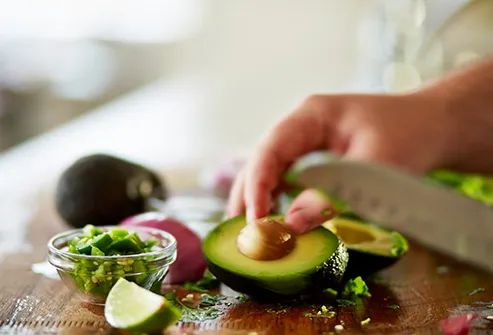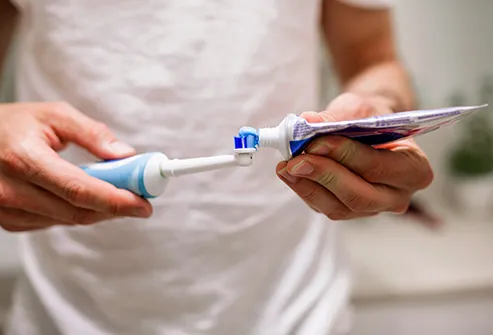Which Health Rules Are Flexible?

1
/
17
Can You Bend the Health Rules?
Trying to be healthy can feel overwhelming. From exercise to nutrition to doctor visits, there's a lot to remember and a lot to fit into your life. Fortunately, most "rules" aren't one-size-fits-all mandates. So where can you take shortcuts or give yourself a break?
Swipe to advance

2
/
17
Water
"Drink eight glasses of water a day" isn't the whole story. The amount of total fluids you need (not just water you drink) depends on things like your health and where you live. You're probably fine if you don't feel thirsty and your pee is clear or pale yellow. Instead of counting, drink a glass of water with each meal and also between them. Drink water before, during, and after exercise, too.
Swipe to advance

3
/
17
General Exercise
Your step counter may say 10,000, but did you break a sweat for any of them? The number isn't magic -- the key here is intensity. For cardio exercise to be effective, you need to get your heart rate up for at least 10 minutes. You can get away with fewer than 20-30 minutes a day (adding up to 150 a week) when you're working harder: 15 minutes of jogging is like a half-hour of brisk walking.
Swipe to advance

4
/
17
Muscle Building
At least twice a week, do something to strengthen your arms, shoulders, legs, hips, abs, chest, and back: Lift weights, use resistance bands, even dig in the garden or shovel snow.
How about making your exercise time do double-duty? A short, intense workout of 30-second exercises like jumping jacks, push-ups, and squats with 10 seconds of rest between improves your heart and lung health as well as your muscles.
Swipe to advance

5
/
17
Flexibility
You should be stretching two days a week (or more) to help you bend and move easily. Gentle practices like yoga, tai chi, and Pilates improve your flexibility and your balance, too.
You've heard to stretch before and after exercise, but research is mixed on whether you really need both. Before a workout may not do any good and might even hurt performance a little. Do your stretches after your muscles are warmed up to help you avoid injuries.
Swipe to advance

6
/
17
Calories
You'll need more calories if you're active, less if you're more sluggish or older. Men generally need more than women. There's a lot of measuring and math to figure out exactly how many you need. Rather than counting calories, focus on healthy eating patterns. Invest your calories wisely. Avoid lots of "empty" ones, like soda, chips, and cookies. Nutrient-rich foods have a better payoff.
Swipe to advance

7
/
17
Fiber
The average person only gets about half of what they need in a day, which is 25-30 grams. To work more fiber into your diet, choose whole-grain versions of foods when you can, like brown rice and whole wheat crackers. Eat a whole-grain food with every meal. And get friendly with beans and legumes! You can add chickpeas to a salad, for example, or mix lentils into your meatloaf.
Swipe to advance

8
/
17
Veggies and Fruits
Forget servings and cups. Every time you eat, aim to get half of your food from the produce section. Reach for veggies and fruits as snacks. Juices count, too, if they're 100%, but the actual fruit or vegetable is better and will help you get your fiber. You want a broad mix of colors and textures.
Swipe to advance

9
/
17
Fats
It's OK for about a third of your daily calories to come from fat! It's the type of fat that can trip you up. Generally speaking, stick with the unsaturated fats from fish and plants like olives, soybeans, avocados, and nuts (but not coconut and palm oils) over the saturated and trans fats from animal sources, fried foods, and baked treats. Choose lean meats and lower-fat versions of dairy foods when you have them.
Swipe to advance

10
/
17
Sugar
Don't worry so much about sugar that's naturally in food. Watch out for added sugars put into foods and drinks as they're made. Limit these to about 6 teaspoons (100 calories) per day for women and 9 teaspoons (150 calories) for men. If you're craving a sweet boost, choose sugar-added foods that also have nutrients, like whole-grain bars or low-fat yogurt.
Swipe to advance

11
/
17
Alcohol
U.S. Dietary Guidelines say women can have one drink per day and men can have two. (A drink is a 12-ounce beer, a 5-ounce glass of wine, or a shot of liquor.) But that's a daily limit -- not an average -- so days without alcohol don't cancel out extra-drinking days. Too much can lead to cancer, high blood pressure, injuries, alcohol abuse, and many other problems.
Swipe to advance

12
/
17
Sleep
Adults usually need 7 or more hours a night. But it's not just about time. The quality of your sleep matters, too. Your sleep needs and patterns will also naturally change as you age. Practice good sleep habits, like going to bed and getting up at the same time, and exercise regularly. You're probably getting enough if you're productive and happy during the day -- without caffeine -- and you don't get sleepy while driving.
Swipe to advance

13
/
17
Brushing and Flossing
The American Dental Association says taking care of your teeth daily means brushing twice and cleaning between them once. You might be inclined to skip flossing, but it's an easy way to prevent big problems down the road. Avoid the regret. If traditional flossing isn't your thing, use a dental pick, pre-threaded flosser, or water flosser to get rid of the plaque between your teeth.
Swipe to advance

14
/
17
Dental Visits
One visit a year might be as good as two. The American Dental Association recommends seeing the dentist regularly. So if you have healthy teeth and great habits, every 12 months could check that box for you. But if you have diabetes or smoke, for example, your dentist may want to see you sooner. Take your cues from her.
Swipe to advance

15
/
17
Annual Physical
Recent research has found that seeing your doctor for a checkup every year doesn't necessarily keep you healthy. If you have no complaints or issues, schedule a visit when you get a new doctor, or if you haven't seen yours in the past few years, to build your relationship. Keep up with preventive tests and vaccines as recommended between your physicals.
Swipe to advance

16
/
17
Eye Exams
If you don't have problems with your vision, you may see less of the eye doctor. Young people should have an eye exam once in their 20s and twice in their 30s. Definitely make an appointment at age 40, when signs of disease often show up. If you're over 65, have your eyes checked every year or so. But you'll need to go more often when you wear glasses or contacts or if you have a disease that could harm your eyes, like diabetes.
Swipe to advance

17
/
17
Try Your Best
Remember, health guidelines are meant to help you live well, not make you feel bad. They're goals, not commandments. Everyone's body, including yours, is different. The best way to know what's right for you is to talk to your doctors and other health care providers. Aim to do better today than you did yesterday. Any effort is better than none.
- Get link
- X
- Other Apps